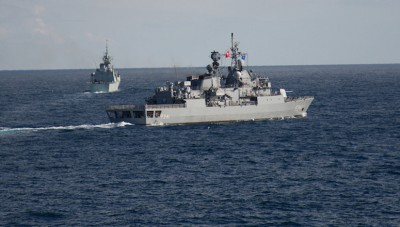Russia Deploys Two Armies, Three Airborne Units to Counter Threat from 40,000 NATO Troops on Its Border

All Global Research articles can be read in 51 languages by activating the “Translate Website” drop down menu on the top banner of our home page (Desktop version).
***
Major Russian officials today have warned of military threats posed by the U.S.-led thirty-nation North Atlantic Treaty Organization to its western border: its entire western border. And its northern one as well.
Russian Defense Minister Sergei Shoigu announced that Russia has redeployed two armies and three Airborne Forces units to its western border as part of what he termed an ongoing readiness inspection.
In one of the sternest warnings issued by a Russian official in the post-Cold War era, Shoigu added,
“We’ve taken proper measures in response to the alliance’s military activities which threaten Russia.” Regarding the ground and airborne forces, the defense minister said: “The troops have manifested complete preparedness and the ability to perform their duties to guarantee the country’s military security. At the present time, these units are involved in exercises.”
He also warned that NATO is now concentrating over 40,000 troops and 15,000 items of armaments and military hardware as well as strategic aircraft near the Russian border, stating: “The troops in Europe are moving towards Russian borders. The basic forces are being amassed in the Black Sea area and in the Baltic region.” He also mentioned the preponderance of U.S. military personnel in those deployments, as the Pentagon is reinforcing troops in Estonia, Latvia, Lithuania and Poland.
In addition he highlighted the fact that: “The alliance annually holds up to 40 large operational training measures of a clearly anti-Russian bias in Europe. In the spring of this year, the NATO allied forces launched Defender Europe 2021 drills, the largest exercise over the past 30 years.” (Estimates range as high as 37,000 U.S. and NATO troops involved in the several-weeks-long war games from the Baltic to the Black Seas and the Balkans.)
The Russian defense minister pointed out that Russia’s western border wasn’t the only location where the U.S. and NATO were threatening his nation. He alsoexpressed alarm over the U.S. and NATO military build-up on Russia’s northern flank, the Arctic. He said:
“The competition between the world’s leading powers for access to the Arctic Ocean’s resource and transport routes is increasing. The US and its NATO allies increase their naval and ground groups in the Arctic, increase the combat training intensity, extend and upgrade the military infrastructure.”
In general Shoigu stated that over the past three years NATO has increased its activity along Russia’s borders.
Also today Russian Deputy Foreign Minister Sergei Ryabkov warned that American warships deployed in the Black Sea off Russia’s coast were a provocation. He was speaking as two U.S. guided-missile destroyers, USS Donald Cook and USS Roosevelt, both equipped to carry 56 Tomahawk cruise missiles and an undisclosed number of Standard Missile-3 anti-ballistic missiles, are to enter the Black Sea tomorrow and the following day. Earlier this year the guided-missile destroyers USS Donald Cook, USS Thomas Hudner and USS Porter and the guided-missile cruiser USS Monterey were in the Black Sea for exercises, often two at a time. (The most, in terms of tonnage, allowed by the 1936 Montreux Convention, though Turkey’s proposed Istanbul Canal may eliminate that limit.)
Ryabkov said that American warships sailing thousands of miles from U.S. naval bases “always involves a geopolitics element.”
His comments are worth citing extensively:
“I wouldn’t like to go too much into particulars of various interpretations of what freedom of navigation and freedom of the seas is, especially in this context. I know one thing: American ships have absolutely nothing to do near our coasts, and this is a purely provocative undertaking. It’s provocative in the literal sense of this word: they’re testing our patience and getting on our nerves. This won’t work.”
And he issued this stark admonition in the context of the Western threats to Russia over Ukraine:
“Apparently seeing itself as the queen of the seas […] the U.S. should understand after all that the risks of various incidents are very high. We warn the U.S. that it should steer clear of Crimea and our Black Sea coast. This would be to their own benefit.”
His warning is a timely one as Ukrainian Foreign Minister Dmytro Kuleba is at NATO headquarters today, where U.S. Defense Secretary Lloyd Austin arrives tomorrow and Secretary of State Antony Blinken shortly after him.
*
Note to readers: please click the share buttons above or below. Forward this article to your email lists. Crosspost on your blog site, internet forums. etc.

